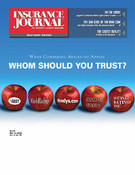Within minutes of recently posting a new poll question on our Web site (www.insurancejournal.com), we quickly learned what some in the insurance industry think of Near North National Group’s Michael Segal.
As Insurance Journal Midwest Editor Kevin O’ Reilly has been reporting on our Web news and in the Midwest IJ magazine, Segal is presently on trial in federal court on mail fraud and racketeering charges related to the alleged embezzlement of more than $20 million from his firm’s premium fund trust account.
As of last week, more than 85 percent of our Web site readers predicted Segal would be found guilty at the conclusion of the trial. Segal, who is of course presumed innocent before a verdict is reached, is not the first person by far in the industry to allegedly run afoul of the law.
As I noted in a recent piece, industry fraud is unfortunately here to stay for the foreseeable future.
According to Jim Quiggle, director of communications at the Coalition Against Insurance Fraud (www.insurancefraud.org), the Coalition estimates that insurance fraud amounts to $80 billion a year. As for agent fraud Quiggle said, “No exact numbers exist, but the troubled economy, commission cuts and competition have placed so much pressure on producers that they’re looking for diverse new revenue sources. Fraud is one source for the dishonest agents.”
Quiggle said analysis shows the vast majority of agents are honest, but we see growing numbers of agents involved with schemes to bilk clients and prospects. This is true on the property and casualty, and life and health sides. According to Quiggle, independent agents seem to comprise the largest number of dishonest producers, but captives also are involved.
“On the P/C side, most of the scams appear to be in personal lines,” Quiggle told Insurance Journal. “Sliding is prominent, and diverting premiums for personal use appears to be sharply rising. On the commercial side, we’re seeing agents selling bogus coverage, engaging in premium-finance scams, and diverting premiums.”
What can the industry do about this costly problem?
Well, I’m no law enforcement officer, although I spend way too much time watching the show COPS, but two suggestions right off the top of my head would be better background checks on prospective employees and stiffer
penalties.
On a recent fraud case about which we reported, one reader wrote that the penalty given to the convicted was a slap on the wrist.
Are judges not seeing the fallout from fraud? It not only is a financial hit on the companies involved, but it trickles down to the consumer. If a company has to pay large legal fees and so on to clear its name, those costs are going to be passed on at some point to the consumer.
What are your thoughts on combating industry fraud? Drop me a line and we’ll talk to you soon.
Was this article valuable?
Here are more articles you may enjoy.


 MAPFRE Accuses AAA of Violating Long-Time Exclusive Marketing Agreement
MAPFRE Accuses AAA of Violating Long-Time Exclusive Marketing Agreement  High-Net-Worth Risk Appetite Drops as Some Regions Show Stabilization
High-Net-Worth Risk Appetite Drops as Some Regions Show Stabilization  Kansas Man Sentenced to Probation for Insurance Fraud
Kansas Man Sentenced to Probation for Insurance Fraud  Relief But Questions on Agents’ Duties to Insureds After Florida Court Ruling
Relief But Questions on Agents’ Duties to Insureds After Florida Court Ruling 


